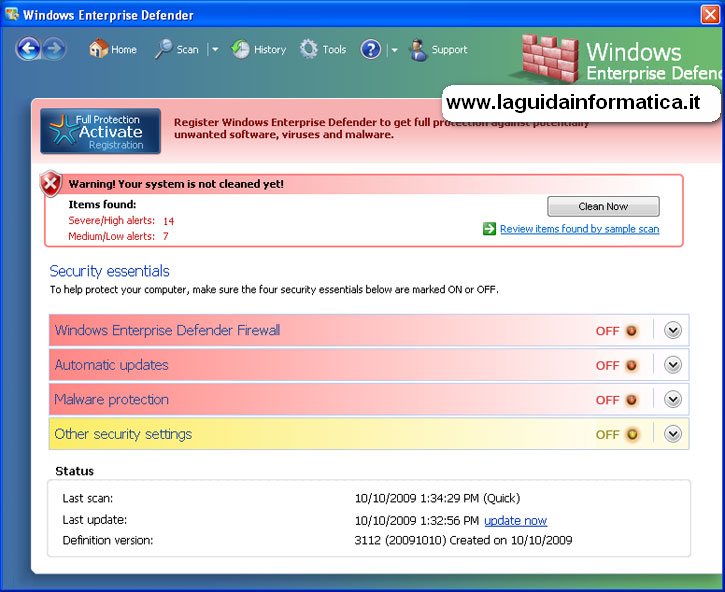Windows Enterprise Defender (da non confondere con Windows Defender) è un falso software di sicurezza della stessa famiglia di SysAntivirus 2009 e PC Defender 2008.
Il falso software di sicurezza una volta infettato il pc, avvia false scansione facendo credere all’utente di avere il sistema infettato, invitandolo ad acquistare la licenza del falso antivirus per disinfettarsi.
Ovviamente non acquistate nulla!
I sintomi che presenta un pc rimasto vittima di Windows Enterprise Defender sono:
sistema rallentato, settaggi del browser modoficati, apertura continua di finestre pop-up durante la navigazione ed infine l’impossibilità in alcuni casi di collegarsi ad internet.
Questi sono i files creati dal falso antivirus:
c:\Documents and Settings\All Users\Application Data\c9ba
c:\Documents and Settings\All Users\Application Data\c9ba\83.mof
c:\Documents and Settings\All Users\Application Data\c9ba\mozcrt19.dll
c:\Documents and Settings\All Users\Application Data\c9ba\sqlite3.dll
c:\Documents and Settings\All Users\Application Data\c9ba\unins000.dat
c:\Documents and Settings\All Users\Application Data\c9ba\WED.ico
c:\Documents and Settings\All Users\Application Data\c9ba\WindowsEDefender.exe
c:\Documents and Settings\All Users\Application Data\c9ba\WEDDSys
c:\Documents and Settings\All Users\Application Data\c9ba\WEDDSys\vd952342.bd
c:\Documents and Settings\All Users\Application Data\WEDDSys
c:\Documents and Settings\All Users\Application Data\WEDDSys\wed.cfg
%UserProfile%\Application Data\Microsoft\Internet Explorer\Quick Launch\Windows Enterprise Defender.lnk
%UserProfile%\Application Data\Windows Enterprise Defender
%UserProfile%\Application Data\Windows Enterprise Defender\cookies.sqlite
%UserProfile%\Desktop\Windows Enterprise Defender.lnk
%UserProfile%\Recent\cb.sys
%UserProfile%\Recent\ddv.dll
%UserProfile%\Recent\eb.sys
%UserProfile%\Recent\energy.exe
%UserProfile%\Recent\pal.sys
%UserProfile%\Recent\PE.drv
%UserProfile%\Recent\ppal.exe
%UserProfile%\Recent\tempdoc.tmp
%UserProfile%\Start Menu\Windows Enterprise Defender.lnk
%UserProfile%\Start Menu\Programs\Windows Enterprise Defender.lnk
c:\Program Files\Mozilla Firefox\searchplugins\search.xml
Queste invece le chiavi di registro:
HKEY_CLASSES_ROOT\CLSID\{3F2BBC05-40DF-11D2-9455-00104BC936FF}
HKEY_CLASSES_ROOT\WindowsEDefender.DocHostUIHandler
HKEY_USERS\.DEFAULT\Software\Microsoft\Internet Explorer\SearchScopes “URL” => “http://search-gala.com/?&uid=7&q={searchTerms}”
HKEY_USERS\S-1-5-18\Software\Microsoft\Internet Explorer\SearchScopes “URL”
HKEY_CURRENT_USER\Software\Microsoft\Windows\CurrentVersion\Internet Settings\5.0\User Agent\Post Platform “[xSP_2:61a6083b6194a2314e3dd54cf9615e36_7]”
HKEY_CURRENT_USER\Software\Microsoft\Windows\CurrentVersion\Internet Settings\5.0\User Agent\Post Platform “876902803”
HKEY_LOCAL_MACHINE\SOFTWARE\Microsoft\Windows\CurrentVersion\Run “Windows Enterprise Defender”
Come disinfettarsi.
Il tool che si è dimostrato efficace nel rimuovere Windows Enterprise Defender è:
:
Malwarebytes Anti-Malware – Download
Disinfettarsi con Malwarebytes Anti-Malware
Scaricate Malwarebytes’ Anti-Malware sul desktop e procedete con l’installazione.
Avviate il software, procedete prima con l’update e successivamente effettuate una scansione in modalità “rapida” del sistema.
Selezionate tutti i malware scovati dal tool e cliccate su “Rimuovi selezionati”.
Ottenuto conferma che tutti i malware sono stati eliminati, potete chiudere il programma e riavviare il sistema.
In alternativa, risultano altrettanto altrettanti efficaci i seguenti software:

